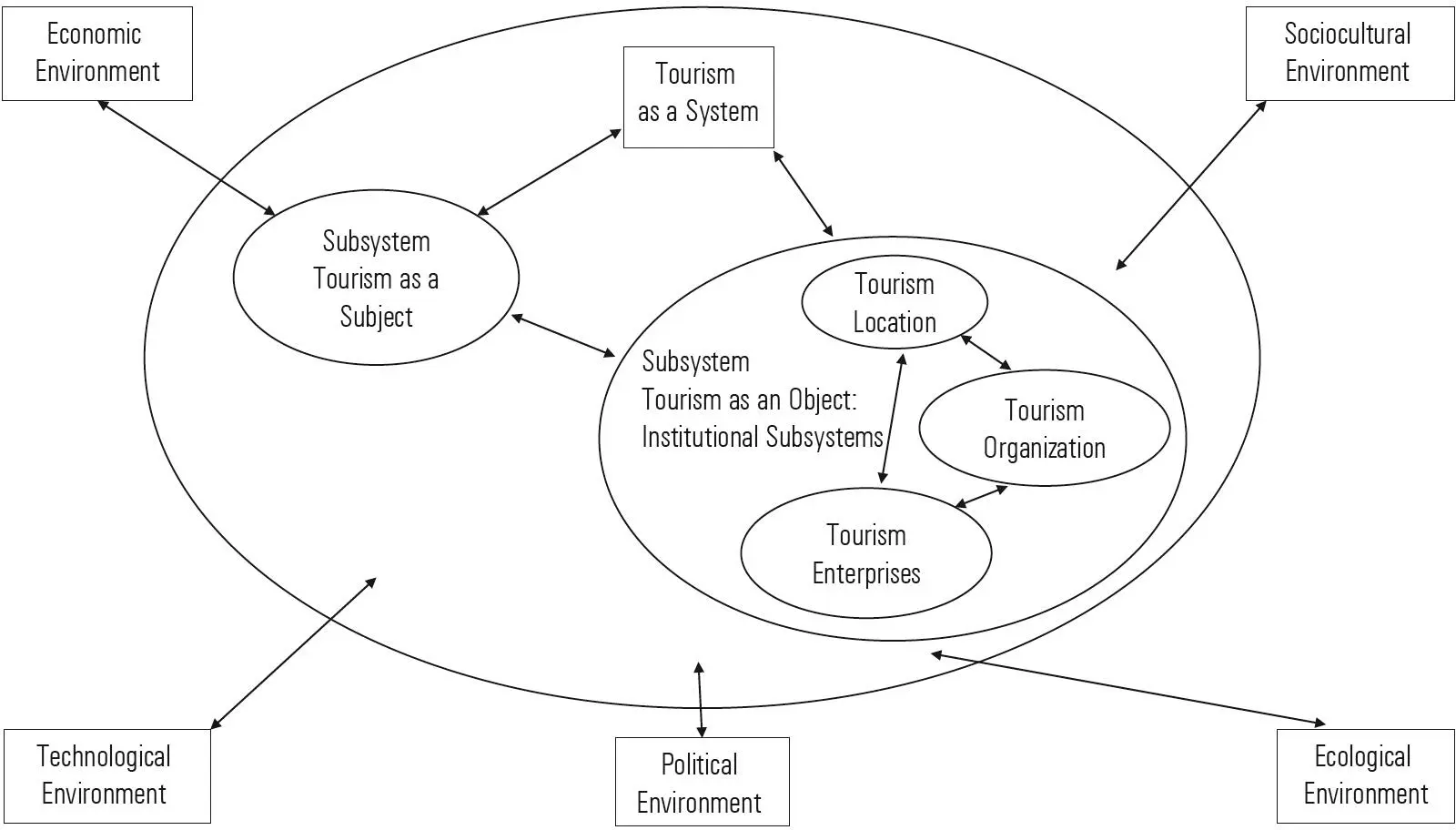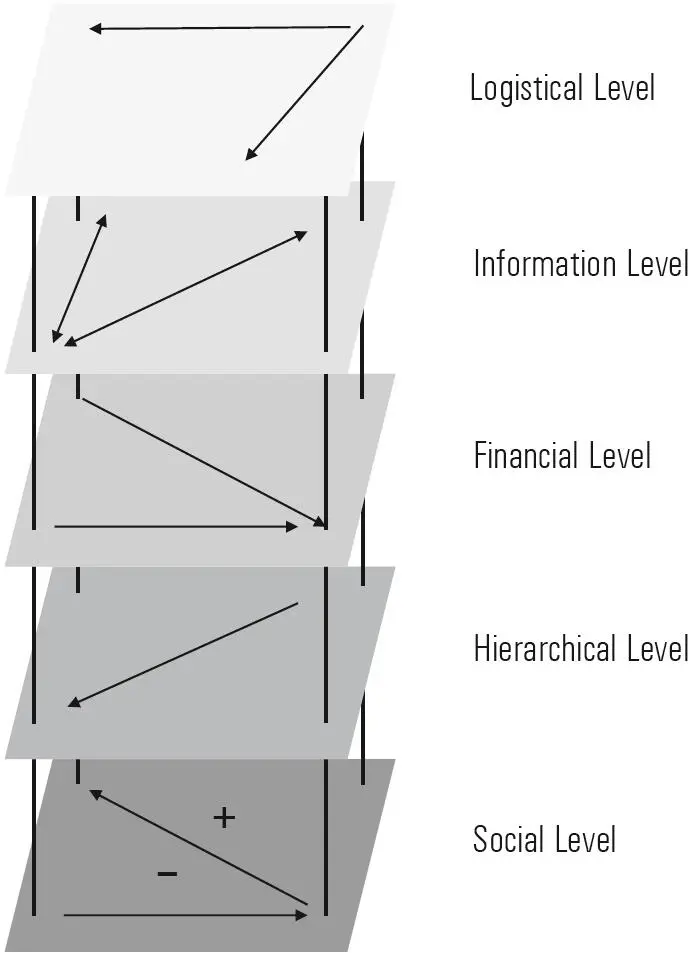1.5 Thinking in Systems and Processes
As mentioned, thinking in systems and processes is a cornerstone of the St. Gallen Management Model. Systems thinking claims to enable interdisciplinary perspectives. Process thinking is intended to interconnect individual functions. In a value creation process, for instance, this would involve purchasing, production, and marketing. Accordingly, many companies are also no longer organized by functions but by performance processes, which enables overcoming functional thinking silos. Instruments such as working with networks in integrated problem solving (Probst & Gomez, 1991), or using process maps to handle complex issues, resemble “boundary-spanning objects” (see Spee & Jarzabkowski, 2009). Below, we present the essential characteristics of systems and processes.
1.5.1 System View of Organizations
[36] Ulrich (1968, p. 105) defined systems as an “ordered totality of elements between which relationships of some sort exist or can be established.” These elements can be represented by graphs in which arrows show the relationships between elements (Figure 1-8).

Figure 1-8: Tourism as an Illustrative Example of an Open System
Source: Bieger (2010, p. 64); based on Kaspar (1996, p. 12)
Different types, each describing the structure of systems and often represented as networks, are evident (see also Bieger, Pechlaner, Liebrich, & Beritelli, 2004). Thus, star networks, on the one hand, and mesh networks, on the other, are extreme cases (Figure 1-9). Pure star networks are centered on one element that “controls” the network, so to speak. Network development, however, also depends on the capacities of this central element. Consider logistics networks: For example, the hub-and-spoke networks of airlines handle traffic via a central hub (i.e., an airport offering transfer connections). Other examples include management consulting teams or the classical structures of academic chairs at universities, where all communication and working relationships are steered and thus also monitored by the managing partner or the chairholder (full professor).
[37] In mesh networks, relationships exist between different elements. In extreme cases, every element is connected with all others. The advantage of such systems is their redundancy. If one element fails, its functions can be performed by other elements. This basic idea also underpinned the development of the World Wide Web. In previous IT structures, remote terminals were connected to a central computer. If this failed (e.g., due to a terrorist attack or a technical fault), the entire IT system was paralyzed. Initiated by the military, the development of the World Wide Web sought to create an IT system that would continue functioning even in adverse cases because all computers were interconnected (see Deitel, 2012). On the downside, these systems are difficult to control because the central node through which everything could be controlled is missing.
A special case of the mesh network is the grid network. This consists of a rectangular network whose elements are connected to their neighboring elements on all four sides. If one of the nodes in a grid network fails, it is possible to switch to parallel connections. This explains why grid networks are often used in road and traffic planning.

Figure 1-9: Exemplary Types of Networks to Represent Systems.
[38] Every organization consists of different system levels (see, e.g., Schräder, 2000, p. 153). For example, a socio-technical organization such as a hospital has the following levels:
– a logistical level on which patient flows occur and on which different service elements (e.g., radiology department, laboratory, operating rooms) are combined to form a specific service chain for patients;
– an information level on which patient data are collected and made available in close conjunction with the logistical level;
– a financial level on which the financial flows between the different elements take place (e.g., the billing of services from the X-ray department to the treating ward and the individual patient);
– a hierarchical level consisting of reporting relationships and cooperation structures (e.g., in projects);
– a social level comprising personal and business acquaintances and informal communication relations.

Figure 1-10: Schematic Representation of System Levels Using the Example of a Hospital
Source: Bieger (2010, p. 75)
[39] These different levels influence each other (Figure 1-10). Thus, good interpersonal relations between two department heads positively impacts the logistical level by facilitating cooperation.
Systems can also be distinguished according to whether they are trivial or complex (von Foerster, 1993). Trivial systems are characterized by their stability (i.e., the same relations always exist between the same elements). Thus, one element has a stable effect on another: For example, if one element grows, the other element also grows. Many logistics systems are trivial systems — for instance, a firmly coupled value chain supplying glasses and involving a stable relationship between the suppliers of semi-finished products, manufacturing, and delivery to retailers. Such systems can be easily analyzed and controlled. In terms of Ashby’s Law (Ashby, 1985), their variety is low, meaning the entire system can be controlled with individual interventions (e.g., changing production capacity).
Matters are different with complex systems. These are characterized by:
– Openness. Complex systems constantly receive external impulses. As a socio-technical system, a company is affected, for example, by cultural values changing in its social environment, which in turn change employee behavior.
– Structural instability. The system restructures itself continuously, as individual elements or relationships emerge or disintegrate. For example, when communication relationships between individual organizational members stall in a hierarchical system due to conflicts, or even when leading figures are dismissed as a result of these conflicts and thus cease to be system elements.
– Tilting effects. The relationship between the elements is nonlinear, allowing tilting effects to occur. This happens, for example, when a management relationship is too strongly focused on performance and control, and intrinsic motivation suddenly vanishes as a result.
– Multilayeredness. The elements change their mode of action and behavior, especially if they are affected by changes on another impact level or by another system. If a manufacturing department [40] reduces maintenance due to cost-cutting measures (impact of the financial level), and malfunctions become more frequent as a result, this in turn impacts the system’s logistical level.
– Historicity. Complex or nontrival systems are historical. Their current state and way of operating depends — among other aspects — on their past. Basically, any event or decision can alter the current state and way of operating. Vice versa, historicity also means that prior decisions inform current and future ones. So-called path dependencies can occur. For example, an organization keeps using a certain software package, even though more potent alternatives have become available in the meantime.
Читать дальше















